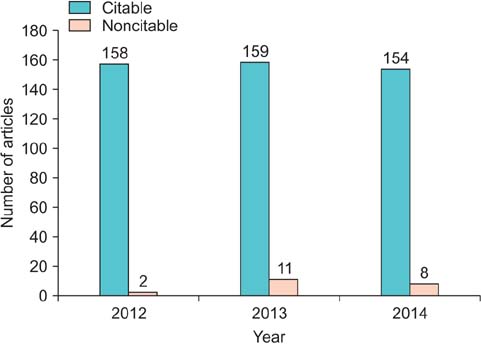Korean J Urol.
2015 Apr;56(4):276-279. 10.4111/kju.2015.56.4.276.
How much progress has been made in journal metrics two years after the citation analysis of the Korean Journal of Urology?
- Affiliations
-
- 1Department of Parasitology and Institute of Medical Education, Hallym University College of Medicine, Chuncheon, Korea. shuh@hallym.ac.kr
- KMID: 2155302
- DOI: http://doi.org/10.4111/kju.2015.56.4.276
Abstract
- PURPOSE
In April 2013, the journal metrics of the Korean Journal of Urology (KJU) were reported. That report showed tremendous improvement from the point of view of journal metrics. Two years later, the same metrics were reanalyzed to determine the present position of the KJU among the international journals in the Web of Science.
MATERIALS AND METHODS
I analyzed journal metrics of the KJU such as impact factor, total citations, and h-index by use of the same methods as in the previous report.
RESULTS
Total citations in the Web of Science were 332 in 2012, 439 in 2013, and 578 in 2014. Manually calculated impact factors from 2012 to 2014 were 0.770, 0.824, and 0.751, respectively. There was an increase in the h-index from 8 in 2012 to 11 in February 2015. Editorial board members were from 15 countries in 2014. Authors of KJU articles were from 21 countries in 2014.
CONCLUSIONS
During 2 years, remarkable progress was made in KJU's citation indicators and in the diversity of the authors' and editorial board members' countries.
Keyword
MeSH Terms
Figure
Cited by 1 articles
-
Clinics in Orthopedic Surgery's Evolution into an International Journal Based on Journal Metrics
Sun Huh
Clin Orthop Surg. 2016;8(2):127-132. doi: 10.4055/cios.2016.8.2.127.
Reference
-
1. Huh S. Citation analysis of the Korean Journal of Urology from Web of Science, Scopus, Korean Medical Citation Index, KoreaMed Synapse, and Google Scholar. Korean J Urol. 2013; 54:220–228.2. Huh S. Journal metrics-based position of diabetes & metabolism journal after the change of its text language to english. Diabetes Metab J. 2014; 38:187–193.3. Huh S. How far has the international neurourology journal progressed since its transformation into an english language journal? Int Neurourol J. 2014; 18:3–9.4. Huh S. Citation analysis of The Korean Journal of Internal Medicine from KoMCI, Web of Science, and Scopus. Korean J Intern Med. 2011; 26:1–7.5. Huh S. How far has The Korean Journal of Internal Medicine advanced in terms of journal metrics? Korean J Intern Med. 2013; 28:635–638.6. Huh S. Revision of the instructions to authors to require a structured abstract, digital object identifier of each reference, and author's voice recording may increase journal access. J Educ Eval Health Prof. 2013; 10:3.7. Huh S. How journal metrics illustrate the transformation of archives of plastic surgery into an international journal. Arch Plast Surg. 2014; 41:617–619.8. Huh S. Journal Article Tag Suite 1.0: National Information Standards Organization standard of journal extensible markup language. Sci Ed. 2014; 1:99–104.9. Huh S. Coding practice of the Journal Article Tag Suite extensible markup language. Sci Ed. 2014; 1:105–112.10. Jeong GH, Huh S. Increase in frequency of citation by SCIE journals of non-Medline journals after listing in an open access full-text database. Sci Ed. 2014; 1:24–26.11. Kim N. Past, present, and future of Journal of Neurogastroenterology and Motility. Sci Ed. 2014; 1:43–45.12. Yang CW. The Korean Journal of Internal Medicine's long road to being listed in the Science Citation Index Expanded. Sci Ed. 2014; 1:118–121.13. Lammey R. Practice of CrossRef extensible markup language coding and more advanced information for CrossRef deposits. Sci Ed. 2014; 1:91–98.14. Lammey R. CrossRef developments and initiatives: an update on services for the scholarly publishing community from CrossRef. Sci Ed. 2014; 1:13–18.15. Chang JH. An introduction to using QR codes in scholarly journals. Sci Ed. 2014; 1:113–117.16. Im J. Applying open researchers and contributors ID in scholarly journals. Sci Ed. 2015; 2:28–31.17. Lammey R. CrossRef text and data mining services. Sci Ed. 2015; 2:22–27.18. Park K. A commitment to excellence. Korean J Urol. 2015; 56:1–2.
- Full Text Links
- Actions
-
Cited
- CITED
-
- Close
- Share
- Similar articles
-
- Citation Analysis of the Korean Journal of Urology From Web of Science, Scopus, Korean Medical Citation Index, KoreaMed Synapse, and Google Scholar
- How far has The Korean Journal of Internal Medicine advanced in terms of journal metrics?
- A Bibliometric Analysis Using Alternative Metrics for Articles in the Annals of Rehabilitation Medicine
- Researcher and Author Impact Metrics: Variety, Value, and Context
- Citation Analysis of the Journal of Bone Metabolism from Korean Citation Index, Web of Science, and Scopus


